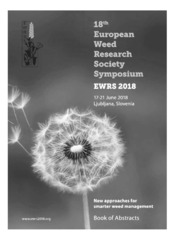Приказ основних података о документу
Maize response to weed interference under changed production technology
| dc.creator | Simić, Milena | |
| dc.creator | Dragičević, Vesna | |
| dc.creator | Brankov, Milan | |
| dc.creator | Babic, Milosav | |
| dc.date.accessioned | 2022-10-21T06:07:45Z | |
| dc.date.available | 2022-10-21T06:07:45Z | |
| dc.date.issued | 2018 | |
| dc.identifier.uri | http://rik.mrizp.rs/handle/123456789/1011 | |
| dc.description.abstract | Weeds interfere with the utilization of resources and thus adversely affect https://www. sciencedirect.com/topics/agricultural-and-biological-sciences/crop-production. Intensity of their interference is especially important during stages when yield is being determined. Weed species differently response to herbicides and this may reflect differences in selection pressure caused by a cropping system. Under changed row space of maize and plant density, weed abundance and biomass production are also different. Fertilizer application and soil fertility have a definite influence on weed diversity and growth, and maize leaf area index, harvest index and yield. The investigations were conducted in the MRI Zemun Polje, Belgrade, Serbia during 2014-2016. Nitrogen fertilizer was applied in two forms: standard urea and slow realize urea with ureaze inhibitor, applied at maize stage BBCH 05. Herbicides mix for grasses and broadleaf weeds were applied pre-emergence (s-metolachlor + mesotrione) and post-emergence (nicosulfuron + mesotrione). Maize was sown with row space of 50 cm and 70 cm - 59.500 and 83.333 plants per ha, respectively. Three weeks after herbicide application, dry matter was measured from uprooted weeds from 1 m2 randomly selected in each elementary plot. Maize parameters – LAI, HI and grain yield were evaluated when plants fully matured. The data were processed by ANOVA. Weed dry matter was highly dependent on the year and time of herbicide application, as well as of some interactions: year x urea form, year x herbicide application and year x urea form x herbicide application. Differences in average weed dry matter between urea forms and maize row space were not noticeable. The lowest weed dry matter was obtained after post-emergence herbicide application (5.01 g m-2). Based on the correlation analysis, weeds very significantly and negatively influences leaf area index (R2 = - 0.524), harvest index (R2 = - 0.598) and grain yield of maize (R2 = - 0.688) | sr |
| dc.language.iso | en | sr |
| dc.publisher | Ljubljana : Kmetijski inštitut Slovenije | sr |
| dc.rights | openAccess | sr |
| dc.rights.uri | https://creativecommons.org/licenses/by/4.0/ | |
| dc.source | 18. European weed research society symposium "EWRS 2018", Ljubljana, 17-21.06.2018. - Book of abstracts | sr |
| dc.subject | weeds | sr |
| dc.subject | maize | sr |
| dc.subject | plant density | sr |
| dc.subject | herbicides | sr |
| dc.subject | urea | sr |
| dc.title | Maize response to weed interference under changed production technology | sr |
| dc.type | conferenceObject | sr |
| dc.rights.license | BY | sr |
| dc.citation.spage | 255 | |
| dc.citation.epage | 255 | |
| dc.identifier.doi | 978-961-6998-21-5 | |
| dc.identifier.fulltext | http://rik.mrizp.rs/bitstream/id/4873/8,2018.pdf | |
| dc.type.version | publishedVersion | sr |


